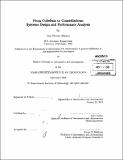| dc.contributor.advisor | Kerri Cahoy. | en_US |
| dc.contributor.author | Marinan, Anne Dorothy | en_US |
| dc.contributor.other | Massachusetts Institute of Technology. Department of Aeronautics and Astronautics. | en_US |
| dc.date.accessioned | 2014-03-19T15:46:42Z | |
| dc.date.available | 2014-03-19T15:46:42Z | |
| dc.date.issued | 2013 | en_US |
| dc.identifier.uri | http://hdl.handle.net/1721.1/85807 | |
| dc.description | Thesis: S.M., Massachusetts Institute of Technology, Department of Aeronautics and Astronautics, 2013. | en_US |
| dc.description | Cataloged from PDF version of thesis. "September 2013." | en_US |
| dc.description | Includes bibliographical references (pages 87-91). | en_US |
| dc.description.abstract | The primary purpose of an Earth observing spacecraft constellation is to obtain global measurements with improved spatial and temporal resolution. The small size, low cost, standardized form factor, and increasing availability of commercial parts for CubeSats make them ideal for use in constellations. In this work, we provide an in-depth analysis of how to evolve from a single Earth-observing CubeSat to an effective CubeSat constellation. We first consider pointing capability provided by three different CubeSat attitude determination and control system (ADCS) architectures to an Earth-observing payload. Our approach of performing a comprehensive orbital altitude and inclination reference point analysis for all subsystems allows us not only to evaluate trades between subsystems when designing a CubeSat that may be manifest in any low-Earth orbit, but the reference point analysis also provides a database of impacts that the orbital parameters have on subsystems and performance for designing a constellation. Next, we consider the practical challenge of trying to launch and distribute a CubeSat constellation into a specific configuration. We suggest a cost-effective way to launch a constellation of CubeSats via consecutive secondary payload launch opportunities. | en_US |
| dc.description.statementofresponsibility | by Anne Dorothy Marinan. | en_US |
| dc.format.extent | 91, A-10 pages | en_US |
| dc.language.iso | eng | en_US |
| dc.publisher | Massachusetts Institute of Technology | en_US |
| dc.rights | M.I.T. theses are protected by copyright. They may be viewed from this source for any purpose, but reproduction or distribution in any format is prohibited without written permission. See provided URL for inquiries about permission. | en_US |
| dc.rights.uri | http://dspace.mit.edu/handle/1721.1/7582 | en_US |
| dc.subject | Aeronautics and Astronautics. | en_US |
| dc.title | From CubeSats to constellations : systems design and performance analysis | en_US |
| dc.type | Thesis | en_US |
| dc.description.degree | S.M. | en_US |
| dc.contributor.department | Massachusetts Institute of Technology. Department of Aeronautics and Astronautics | |
| dc.identifier.oclc | 872116415 | en_US |
